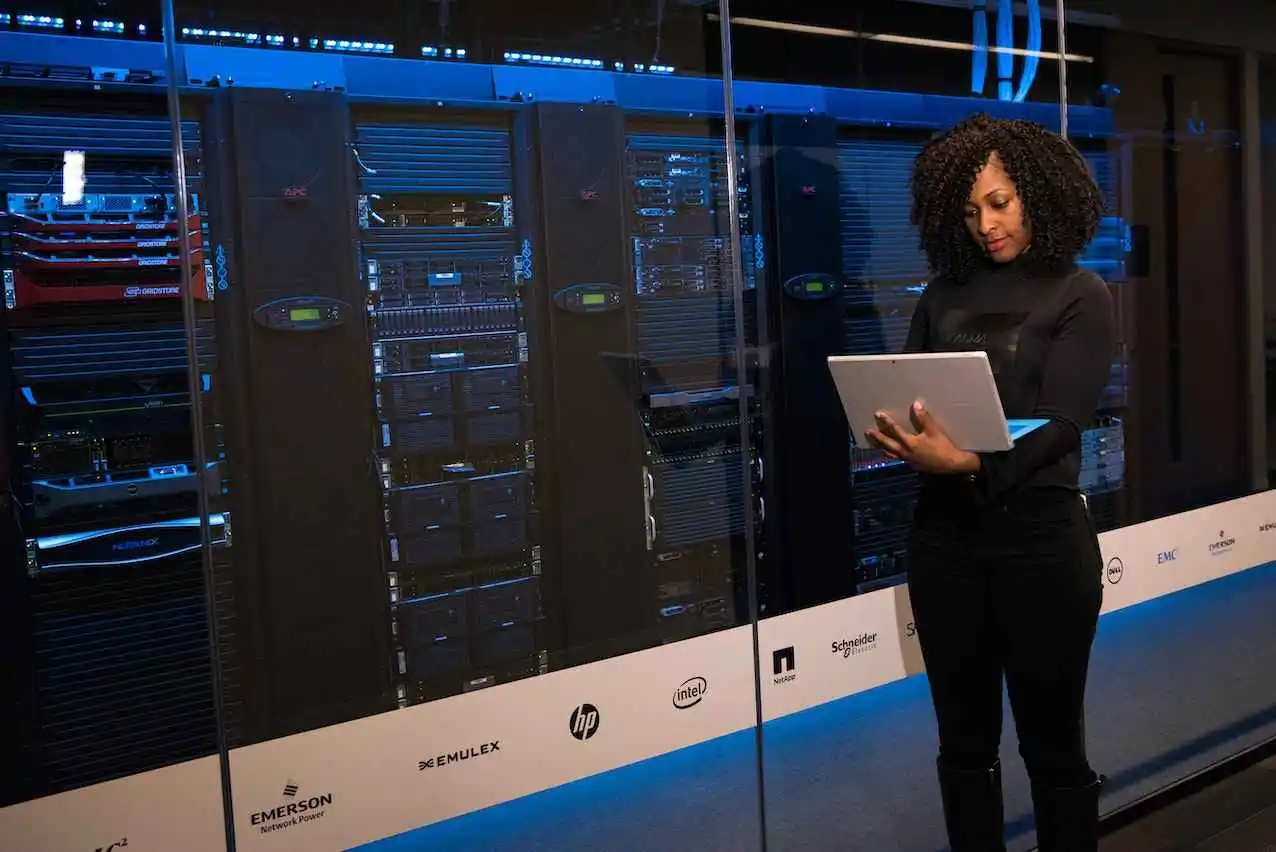
Blockchain technology, which was initially implemented to support Bitcoin transactions, is now playing a crucial role in optimizing numerous marketplaces, business sectors, and procedures across numerous industries. It’s no surprise that the worldwide blockchain technology market will be worth $ 20 billion by 2024, given the revolutionary changes it will bring to the financial services, healthcare, and education sectors.
Developers of mobile apps and software can benefit greatly from the technology because of its decentralized architecture, which ensures the highest level of data security and integrity possible. In this piece, we’ll look at how blockchain technology alters mobile app development and provides businesses and customers with smart IT solutions. We’ll also discuss maximizing your investment return by integrating blockchain technology with mobile apps.
What Exactly Is Blockchain Technology?
Blockchain is a recording system that is extremely difficult (if not impossible) to hack, alter, or cheat. In simple words, a blockchain is a distributed digital log of transactions that is copied and then spread over the whole blockchain network of computers. Each “block” in the blockchain stores several transactions. Each participant’s ledger is updated whenever a new transaction is recorded in the blockchain. Distributed ledger technology refers to a system where multiple parties manage a shared database.
The blockchain is a decentralized ledger technology (DLT) that records transactions using an immutable cryptographic signature called a hash. This ensures that any attempt to alter a block in a given chain will be immediately detectable. To compromise a blockchain, attackers would have to modify all of the blockchain’s distributed copies, one block at a time.
The Potential of Blockchain Technology in Mobile Applications
Companies are increasingly investing in Blockchain Technology to reap its benefits. Let’s find out why this technological innovation is attracting so much attention. Since mobile apps are where blockchain is most commonly applied, let’s look at its primary advantages. The following are some examples of how blockchain technology might be used in conjunction with mobile apps:
-
Offer Sophisticated Digital Ledger System
Numerous servers, networks, and other components make up the mobile application infrastructure. Typically, a client will initiate communication with a server by sending a request, and the server will respond by sending the requested data. Remember that popular mobile apps can generate millions of requests per second, severely damaging the back-end infrastructure.
Overwhelmed servers are now much easier to manage because of blockchain technology. It offers a distributed digital ledger that is capable of working together to process data and fulfill multiple requests simultaneously. This is where the sophisticated ledger system comes into play; it will trigger updates on all machines only once the transactions have been verified as safe. The data is protected from any tampering.
-
Enable Sophisticated Safety For Multi-User Mobile Apps
The mobile app has evolved from its simpler beginnings and is now more complex. Modern smartphone apps have a lot on their plates, one of which is catering to several users at once. The program must guarantee that unauthorized users can’t get to any sensitive data. The information must be protected from tampering, editing, and inappropriate use.
Blockchain technology makes it extremely difficult for users to break into the system because no action is possible without the appropriate encryption and decryption keys. After user authentication, the data is stored on the server and can only be changed by authorized users. Because there are no intermediaries, the transaction is highly secure. This ensures that there will never be an issue, no matter how many people are using the app at once.
-
Improved Security And Discretion In The Development Environment
System crashes are difficult for developers because of the work involved in fixing them. They have no idea how to fix the problems after a system failure. Due to the high volume of requests, developers can’t monitor every single one in real time and fix them as they appear. Malware has the potential to do extensive damage before developers discover the problem.
Blockchain technology may provide an excellent answer to this issue. Its open design makes it easier to spot and stop attacks of this kind. When using blockchain technology, consumers can easily keep tabs on their data. The system is secure from outside interference since data changes require authentication.
Developers can maintain domain name system (DNS) records because of the accumulated DNS data. In other words, until the developers give the go-ahead, no one will be able to modify the entries.
-
Innovation With Constant Development
With blockchain technology being in its infancy, numerous improvements will likely be made soon. In ten years, blockchain technology will have matured significantly.
So how does this relate to app development for mobile devices? The good news is that blockchain technology is already being used in numerous mobile apps. Since blockchain is always evolving, new features and mobile app improvements are expected.
As blockchain technology evolves, it will become more practical and trustworthy. This bodes well for the future of mobile applications, and the use of blockchain technology in these apps will provide additional advantages.
-
Streamline Approval And Update Process
The updates for both Google Play and the iOS App Store are handled automatically. They can complete the updating procedure independently of any outside help. For developers, not knowing the quality assurance policies might lead to perplexity when their apps are rejected for unclear reasons.
The blockchain is an open-source technology, which is a huge relief. It’s a helpful tool for developers to monitor and manage their projects’ approvals. There is also a public ledger-connected developer-reputation system. Following standard procedures, developers can confidently release their apps without worrying about harmful viruses and other malware. Blockchain technology will instantly scan the program for any malicious code when they upload the program to the system.
After the application has been scanned, it is temporarily stored until a human can examine it. The verification occurs later on. After a few more development hours, the app will be released to the public.
-
Put An End To Economic Worries
At least 30% of what developers make from their apps’ in-app purchases and ads goes to the app store. That’s a whole lot of cash to have on hand. There are a few CPI bundles the developers need to purchase, and they don’t come cheap.
With in-app purchases, developers face the added complexity of dealing with different fees, including those associated with financial transactions and credit card use. The business model is not in the developers’ favor.
The use of blockchain technology is revolutionary for addressing monetary issues. Developers can incentivize users to use their apps for a set time using a blockchain-based smart contract that eliminates the need for a third party. Thanks to the CPA (Cost per Attention) advertising model, it can generate significant revenue for the creators.
Earned coins can be used for in-app purchases at a later date. As a bonus, the developers get to keep roughly 85% of the profit rather than 70%.
-
Reach Isolated Regions
Smartphones and mobile applications have made it possible for an increasing number of people living in rural locations to access the Internet. However, they have a hard time accessing standard banking and credit services. People in rural locations will be able to conduct online transactions with greater ease because of blockchain technology.
Residents of rural locations might avoid using traditional payment methods like credit cards and banks by keeping pennies in an electronic wallet. It will make it easy for them to shop online, get a loan, and send money home to loved ones.
Guide to Integrating Blockchain Technology into Your Next Mobile App
Having established blockchain’s value, we’ll examine the necessary procedures to integrate it into your next mobile app.
Stage 1: Blockchain-Optimized Applications
There are a wide variety of blockchain-based apps available today. However, there is always a potential that your app won’t require blockchain at all, particularly if it’s a straightforward content-driven app that doesn’t have a transaction feature.
However, blockchain is a great choice if you’re building a payment processing or transaction interface software and need the active backing of a decentralized, secure database. For example, include Apps for shopping, digital wallets, keeping tabs on digital assets, etc.
Step 2: Think about essential technologies
Let’s say you’re considering integrating Blockchain Technology into your mobile app. To do so, you’ll need an in-depth understanding of the technology and its numerous parts, including networks, languages, blockchain platforms, and procedures like front-end, back-end, and QA for various mobile platforms.
Stage 3: Putting Blockchain to Work
As was previously discussed, there are several advantages to utilizing blockchain for mobile apps, which might help propel your company to new heights.
It is time to talk about the process of making a blockchain-based mobile app.
-
Select The Best Approach That Works For You
If you know anything about blockchain technology, you probably know that a mutual consensus mechanism guarantees its security and universal accessibility. Now, select the consensus approach that best fits your project’s requirements.
-
Design Architecture
Select the best setup for your design model now. This means that you should implement a hybrid, cloud, or in-house solution for blockchain hosting. Fortunately, you can choose from several solutions. Make sure that the design architecture you choose is suitable for the mobile operating system platform and technology stack you intend to use to create the app.
-
UI Plus Control Panel
The final step in developing a blockchain app is constructing the user interface and back-end management system. Using dedicated application servers, a front-end programming language and a remote data store should get the job done quickly and easily.
Conclusion
The next several years will see the creation of an unprecedented number of mobile apps integrating blockchain for use in markets as diverse as retail, supply chain management, and banking. It will provide a variety of safe mobile solutions for those fields. An app store built on the blockchain has the potential to become as important as the Google Play Store and the Apple App Store for discovering, downloading, and paying for programs on a mobile device.
Therefore, young companies need to learn about the blockchain and research internet resources related to this topic before attempting to implement it in a mobile app development project.
At Saffron Tech, we know how to create reliable, scalable mobile applications. So, get in touch with us if you’re interested in building a blockchain mobile app. Whether you need assistance with development or an entire app rollout, we’ve got you covered.
Subscribe to Saffron Tech
Explore your marketing zen with our newsletter! Subscribe now.



